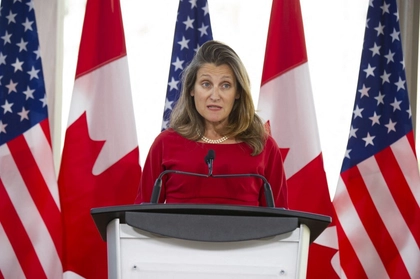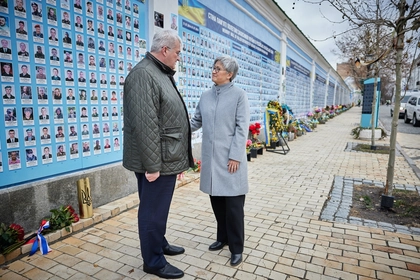On Sept. 3, Russian leader Vladimir Putin visited Ulaanbaatar at the invitation of Mongolian President Ukhnaagiin Khurelsukh, with the latter refusing to honor an arrest warrant for Putin issued by the International Criminal Court (ICC), of which Mongolia is a member.
While Putin received his warm welcome from the Mongols, across the border the Buryats – the Russified Mongol population inside Russia – remains one of the highest casualty groups in Moscow’s invasion of Ukraine, with others joining the Ukrainian side to fight against what they called Russian imperialism.
JOIN US ON TELEGRAM
Follow our coverage of the war on the @Kyivpost_official.
Decades ago, Peljidiin Genden, the first president of communist Mongolia, met his end when he reportedly slapped Soviet dictator Joseph Stalin in the face, knocking his pipe out of his mouth, due to the former’s refusal to implement Stalin’s anti-Buddhist policies.
Nonetheless, the Soviet legacy remains vibrant in Mongolia, with Mongols continuing to use the Cyrillic scripts as opposed to the traditional Mongolian script retained in China’s Inner Mongolia – though that too might change in the near future.
Once a Soviet satellite state – the first and only in Asia – Mongolia’s relations with Moscow have been peculiar, to say the least.
A brief history of modern Mongolia
Modern, independent Mongolia’s existence hinged very much on Soviet support – in fact, it’d be fair to say that modern Mongolia came about because of the USSR.

Canada’s Chrystia Freeland – A Personal View
“We had just one choice: Be as close to Russia as possible to ensure our independence,” Sangaa Bayar, chief of staff for one of the governing party’s deputy chairmen during its communist days, told the Washington Times in 2001.
After the Mongol Empire collapsed in the 14th century, the region later came under Chinese rule during the Qing dynasty in the 17th century.
Outer Mongolia declared its independence in 1911 during the last days of the Qing dynasty, with Bogd Khan, the spiritual leader of Tibetan Buddhism in Mongolia, becoming Mongolia’s theocratic ruler.
In 1919, the Bolsheviks in Russia recognized Mongolia’s independence. The same year, Chinese troops reclaimed Outer Mongolia and ousted Bogd Khan.
The Chinese occupation lasted until February 1921 when White Russian warlord Baron Roman von Ungern-Sternberg, a Baltic nobleman known as the Mad Baron for his eccentric and violent tendencies, ousted Chinese troops and reinstated Bogd Khan.
The Mongolian People’s Party (MPP), which would later come to rule communist Mongolia, was founded in 1920. With the help of Soviet troops, Mongolian revolutionaries expelled the Mad Baron’s forces in July 1921.
The Mongolian People’s Republic was established in 1924 and became a Soviet satellite state until 1990.
Mongolia reportedly attempted to join the USSR but was rejected. Some believe that the USSR decided to utilize Mongolia as a buffer state with communist China instead following the Sino-Soviet split in 1960, during which Ulaanbaatar sided with the USSR.
Purges and oppressions
Though Mongolia’s literacy rate improved drastically during communist rule – in part due to the adoption of Cyrillic alphabets in the 1940s – Soviet-style purges and oppressions also spilled into the country.
Purges targeting the aristocracy and the religious establishment – both firmly rooted in Mongolian society – started in the 1920s in a bid to rid the country of the Buddhist clergy and consolidate communist control.
Communist Crimes, a group that documents communist oppressions, said purges peaked between 1937 and 1939 under the leadership of Khorloogiin Choibalsan, whom the group called “Stalin’s hand-picked man in Mongolia.” It said the purges “resulted in at least 22,000-30,000 victims (about 4-5 percent of Mongolia's population at that time),” with close to 18,000 of the victims being Buddhist lamas.
Genden Tserendulam, the daughter of the Mongolian leader who reportedly slapped Stalin in the face, told the Washington Times in 2001 that she had collected names of 28,185 persons killed between 1937 and 1939 alone, with some 17,000 belonging to the Buddhist clergy.
The Head of the Presidential Commission for Victims of Repression estimated the total number at 100,000.
Between 1929 and 1932, communist Mongolia also attempted to carry out collectivization and liquidation of private property – a move that provoked a massive slaughter of livestock as well as a wave of anti-communist uprisings.
Tserendulam said that “there is no accurate figure for the number of the dead,” with firing squads reportedly grabbing nomadic herders at random and executing them at will during Mongolia’s darkest days.
As for Genden, Tserendulam’s father executed in 1937 on spying charges, he was posthumously declared innocent by Moscow in 1956. However, his daughter wouldn’t learn of this fact until 1991, when confirmation came in a letter from then-Soviet President Mikhail Gorbachev.
During the 2001 interview, Tserendulam said that there are difficulties in collecting information on the purges as surviving victims as one after another passed with old age.
“There are a few thousand left. Sometimes, I interview one and he dies the next week,” she said at the time.
Now, some 23 years later, with Putin visiting Mongolia to discuss bilateral cooperation – including a potential gas pipeline to China that reportedly fell through – whilst conducting his own purges at home, only the Soviet-style apartment blocks and Cyrillic signs remain to serve as silent witnesses to the tragedies that plagued modern Mongolian history.
You can also highlight the text and press Ctrl + Enter






